Pay is one of those sticky subjects. No-one particularly wants to talk about it but everyone wants to know about it. How much do people across the pond get paid? What can I expect my salary to be as I move up the ladder? Are product marketers across the world happy with what they get?
All questions people were wondering, all answers we uncovered.
Before we dig into the juicy details, here are a few things to bear in mind:
- All figures represent base salaries only, excluding bonuses and shares. We felt there were too many variables to consider with all three.
- We split salaries by continent, country and in the US, state. However, not all subsequent stats are segmented geographically and as you’ll soon see, where you are on the map matters.
- We asked all respondents to express their salary in US dollars, whether that’s what they were paid in or not.
- In the survey itself, we asked people to put themselves into salary bands for a few reasons:
- 1) To account for the fluctuating currency conversions of those who don’t get paid in US dollars.
- 2) To eliminate the scope for inaccurate responses that can come with FreeType fields.
- 3) To ensure 100% privacy. Some countries, cities and states only had one representative and for them, the thought of disclosing their exact salary made them uncomfortable.
- Because we didn’t receive enough responses to paint a statistically viable picture, not every country within a continent is called out.
Who took part
All in all, 1,627 product marketers took part in our salary survey. The majority of respondents were based in North America (71%) and the remaining count was made up by Europe (22%), Asia (3%), Australasia (1%) and North & Central America (1%).
Less than 1% of the sample was made up by PMMs from Africa and because the quantity was so much smaller, we weren’t able to representatively include them as a standalone continent.
By position, the divide looked like this:

The average of all averages
Across every continent, country, title, company size, product type, gender, the lot, the average salary for a product marketer came in at $117,041, but not all employment types earned in the six-figure mark:
Across every continent, country, title, company size, product type, gender, the lot, the average salary for a product marketer came in at $117,041, but not all employment types earned in the six-figure mark:
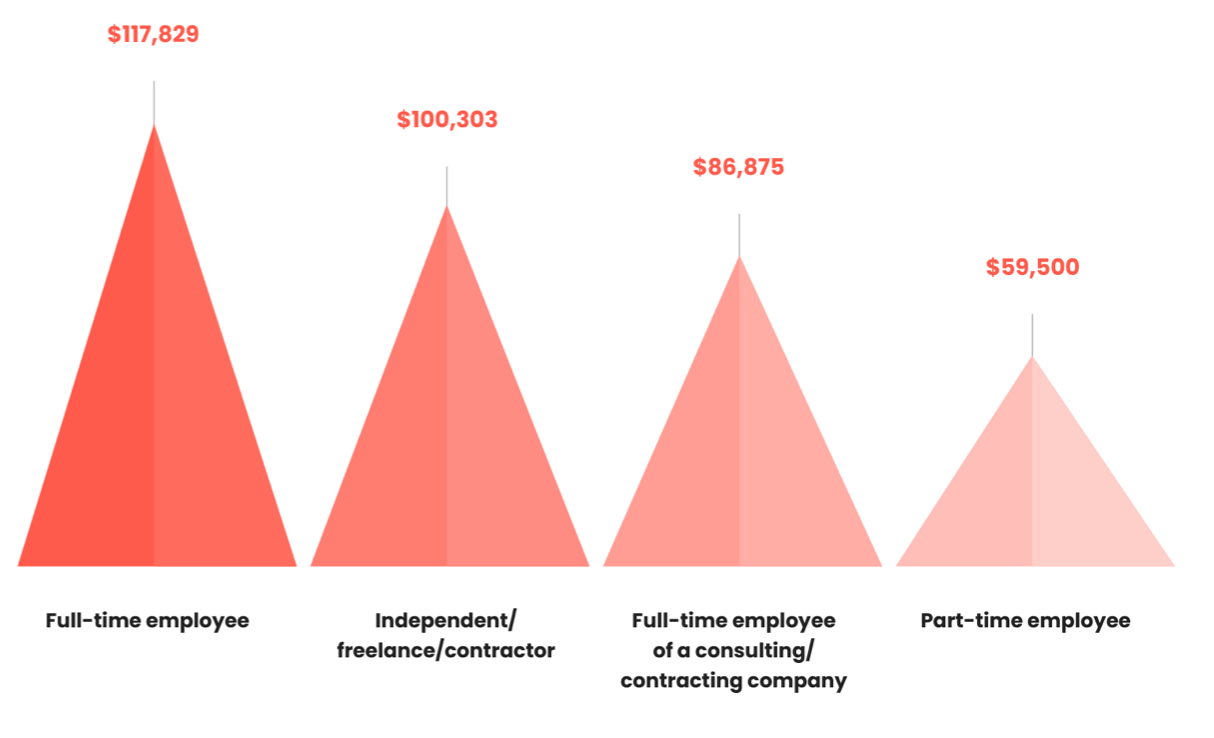
What’s the median salary?
At $112,500, the median isn't a million miles off the average and the best-paid 25% made $187,500, versus $67,500 for the lowest.

And when it came to salary bands, here’s how the product marketing population was split. Of the 2% who were paid less than $25,000, 28% were from India, 25% Brazil, and Russia and the UK claimed 7% each.
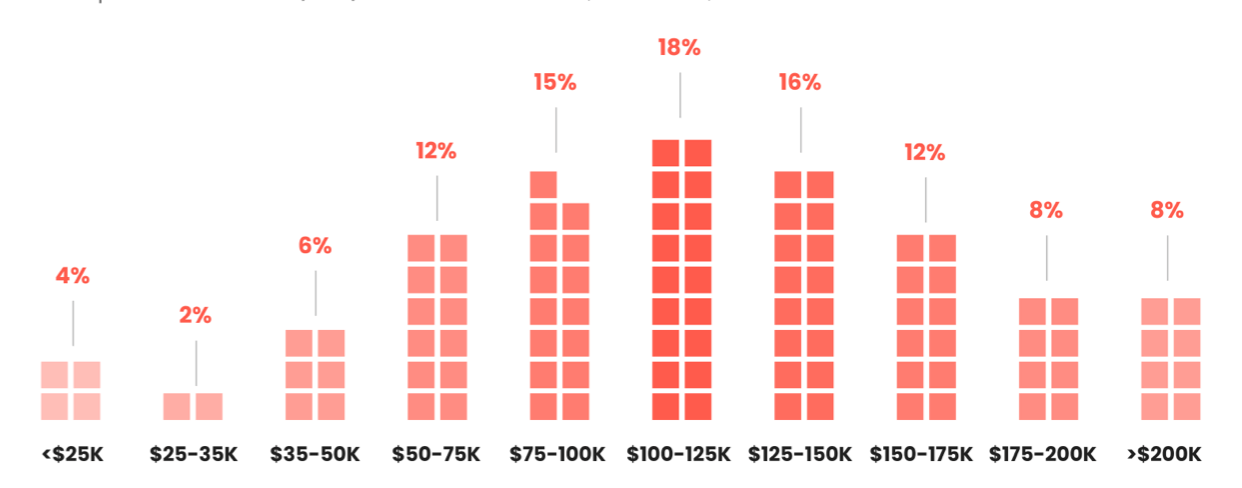
As expected though, there were many other variations depending on all the aforementioned factors and more and next, we’ll explore each.
Location, location, location
With an average annual salary of $134,587, product marketers in North America came out better off than any other continent, earning almost $20,000 more per year than their closest contender, Australasia.
Perhaps unsurprisingly, the US ($137,132) topped the table in North America with Canada ($95,700) some distance behind.
Where you are in America makes a difference too and of the states that had sufficient representation, salaries ranged from $152,307 in California to $95,208 in Ohio.

*= more than five but less than 10 responses
Averages from outside North America solidify where you are in the world really does matter and product marketers in South & Central America receive the lowest remuneration of everyone - which is around $100,000 less than the average North American.
From best to worst, the continental averages were:

And drilling down to a country-level, salaries started to look like this:

“It’s not really a surprise to see this difference in salaries across geographies as they are often based on the cost of living, and I assume are not just limited to Product Marketing.
"However, working in the SaaS industry, I believe these salaries should be levelled more as companies are selling globally and thus are also competing for talent globally. For example, if your company's main market is the U.S. but your HQ is not, should you get paid less than employees of key competitors?”
Bozena Pieniazek, Head of Product Marketing at Typeform
Men vs women
Men - 47%
Women - 52%
The overall split between male and female product marketers is relatively even (47:52%) but on average, men take home $653 more than women a month.
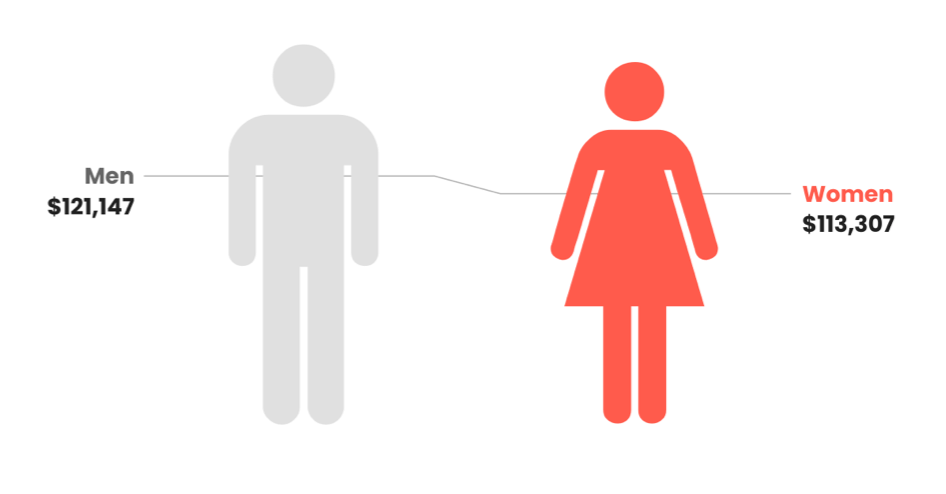
Not everywhere though. In Asia and the Middle East women earn more than men.

How much do job titles matter?
As expected, quite a lot. Salary jumps align with progressive promotions and the average raise is pretty attractive, with the steepest coming during the Product Marketing Manager to Senior Product Marketing Manager transition.

In contrast, when we looked at the US, UK and Canada in isolation (the three largest datasets), the numbers started to look like this:

Other job titles given by product marketers include: Chief Marketing Officer, Product Evangelist, Customer Marketing Specialist, Marketing Solutions Architect, Product Content Specialist, Marketing Manager, Competitive Intelligence Manager, Customer Adoption Manager, Communication Manager, Growth Manager.
When we segmented the data by gender and job title, the splits were:
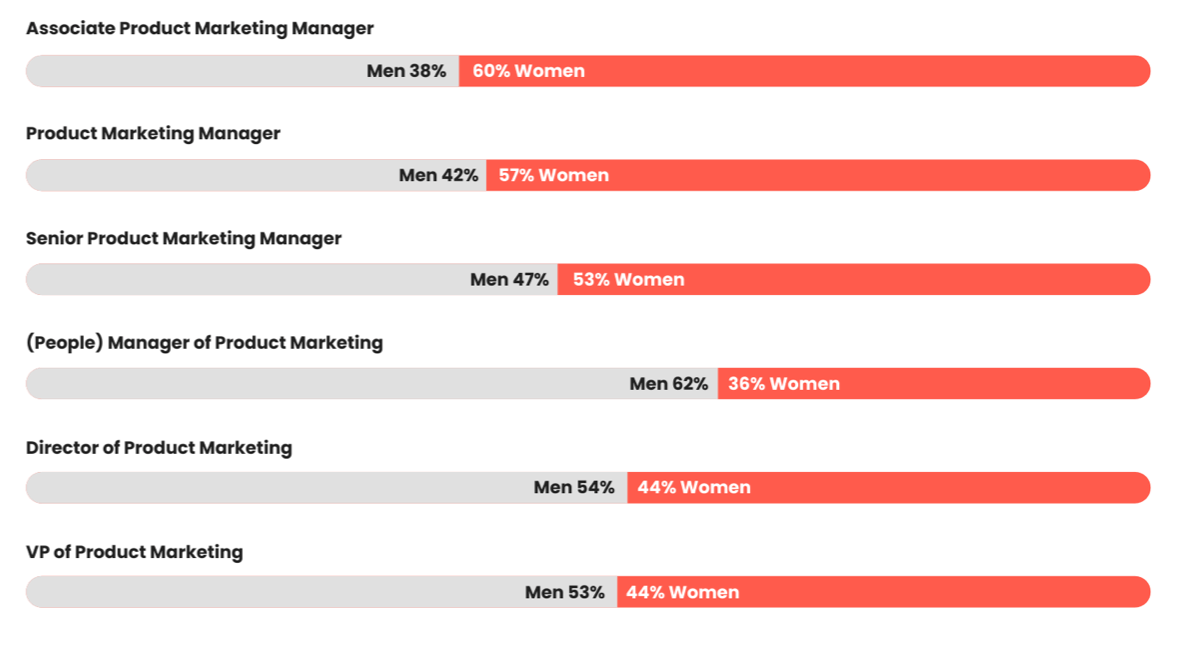
Women occupy more spots earlier on and then as the role gets more senior, the dial changes.
By industry, product and market
Industry-by-industry
Computer Software (35%), Information Technology & Services (19%), Marketing & Advertising (6%), Internet (5%) and Financial Services (4%) were by far the most populated industries overall and their variances weren’t worlds apart.
The average salary for product marketers working in Marketing & Advertising was the highest of the bunch - $122,952, and pay for the lowest of the five was $7,817 less.

With an average annual salary of $138,700 though, product marketers who work in Computer & Network Security (2%) walk away with the higher pay cheque. At the other end of the spectrum, of the industries with double-digit respondents, Consumer Goods tallied the lowest global income - $85,208.
Physical vs SaaS
SaaS is where it’s at and the overwhelming majority of PMMs (74%) market software as a service. Of the outstanding quarter, just 8% work exclusively with a physical product and the rest a blend of both.
When it came to the type of product plus pay, SaaS trumped physical products and people who are employed to deal with both were marginally better off:
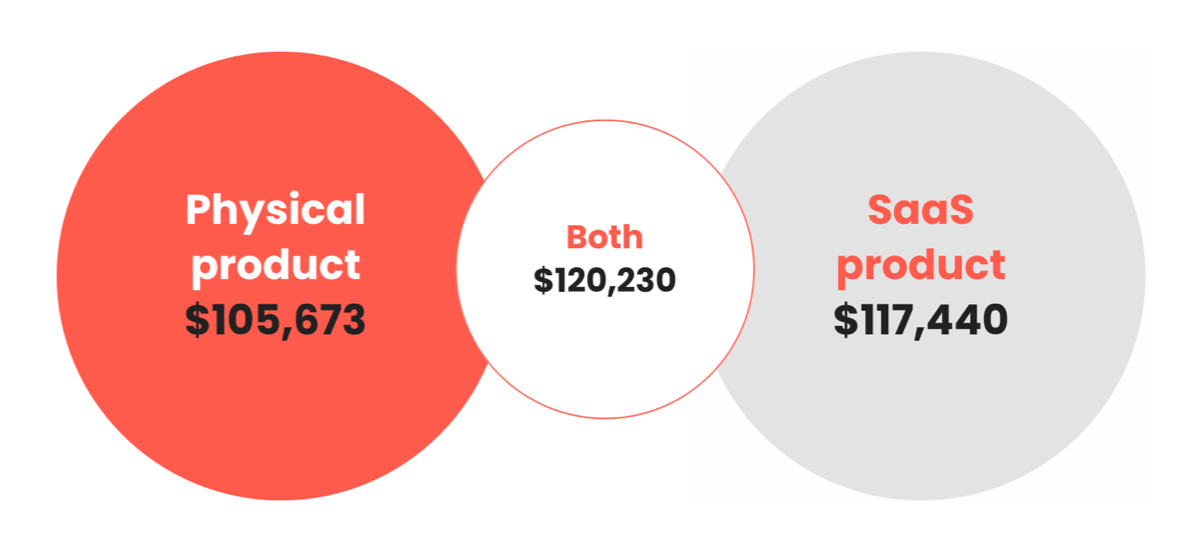
Despite the disparity in pay though, pretty much the same per cent of product marketers felt their salary was reflective of everything their role entails.
Quick-fire fact: Just 6% of the VPs we surveyed work solely with physical products.
We asked Tamara Grominsky, Director of Product Marketing at Unbounce, what she thought about the difference:
“This is so complex because there are a handful of things at play, including company culture, access to data, and even operational costs.
“SaaS startups often have a fast-paced innovative culture, and these companies are willing to pay for candidates who can work at this speed. The release cycles in SaaS are weeks, as opposed to quarters or even years in packaged goods.
“Product Marketers at SaaS companies also have unprecedented access to data on both attribution and customer behaviour. The ability to collect, analyze and present this data is a skill that SaaS PMMs have to master.
“Finally, cloud products have lower operational costs than packaged goods. They don’t have the typical costs associated with supply chain and the storage of physical goods. The result is that companies can leverage these savings to re-invest in the business, and its employees.”
B2B vs B2C
It came as no surprise the split between B2B and B2C product marketers was very much in favour of the former and of the specialists who took our survey, 70% were B2B, just 6% were B2C, and the remaining 24% served both.
The difference in pay isn’t enormous, but it’s there:

Just 5% of product marketers specialise in physical and SaaS products in a B2B and B2C environment and interestingly, there wasn’t a single VP from our survey who worked in B2C.
We asked Jason Friedlander, Senior Director Product Marketing at Verizon, what he thought about the difference in numbers:
“I would say the numbers vary so much because B2C probably considers themselves more as a marketing function whereas the product marketing role aligns directly to B2B. I also think many B2B companies are able to spend more revenue on salaries because it’s usually based on committed sales vs B2C businesses.”
Company factors
Next up, we took a look at company-specific factors like growth stage, employee headcount, revenue, and the number of people who make up the product marketing team.
Stage of growth
While most might expect salaries to increase as companies grow and gain more funding, that wasn’t actually always the case and the average salary went down in between organisations who’re early post-product market fit and mid-growth with an established go-to-market team.
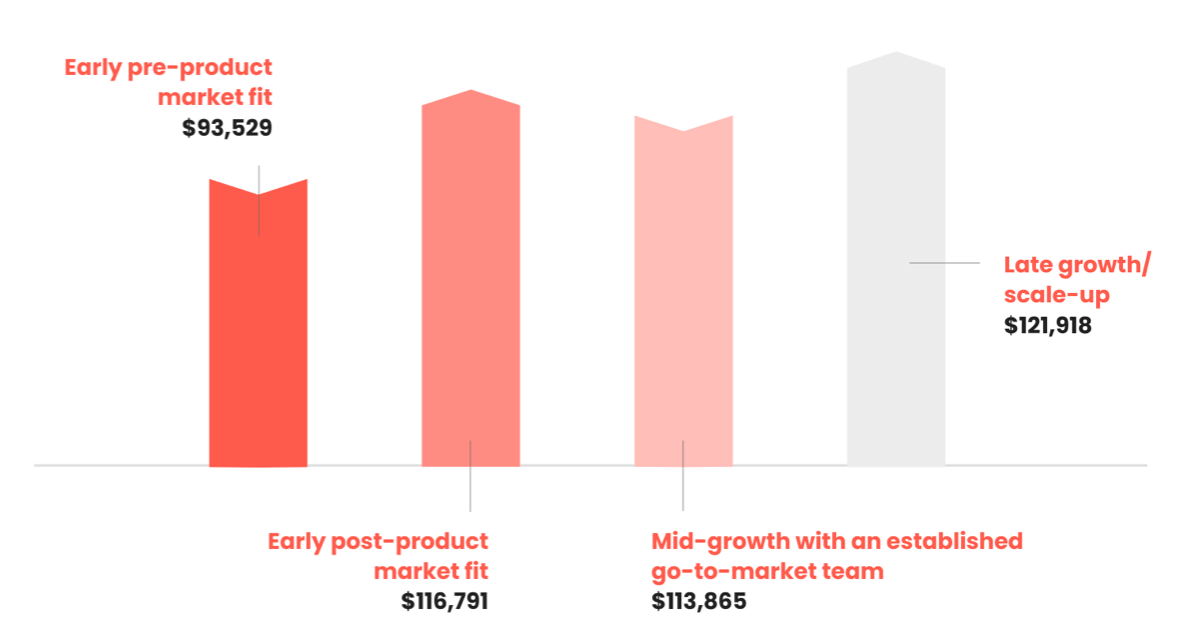
Employee, revenue and team numbers
Product marketers working at companies with the largest employee count (10,000+) took home the biggest salaries ($137,290). Unsurprisingly, three-quarters of those organisations were in North America.
In general, pay increased in tandem with staff headcount but there were a couple of exceptions after the 1,000 mark:

And a very similar trend was present in the company revenue data. Unexpectedly, salaries began to slump after organisations grew to more than $500million in revenue, before a final surge for those exceeding $2billion.

Just under one in 10 (9%) product marketers work for a private company and on average, they’re compensated with $107,217 a year.
Finally, making it a hattrick of patterns, the trajectory of salaries in relation to product marketing team sizes took a knock around the same point too.

Backing from above
When asked if there was strong leadership support for product marketing in their current company, overall, more than six in 10 said yes. However, for B2C product marketers that figure dropped to just over half (51%).
Yes - 62%
No - 37%
There were also quite significant differences depending on seniority. For example, 78% of VPs of Product Marketing answered yes, compared to just 57% of Associate Product Marketing Managers.
And finally, making up the extremes on the map for the better were Australasia (84%) and for worse, Asia (52%).
So, did that higher-level backing make a difference on the whole? Yes, yes it did. On average, product marketers with strong leadership support earn $12,762 more a year.
Wondering how you can get the C-suite invested? Here’s what Martin Aguinis, Product Marketing Manager at Flutter, a Google company, had to say:
“Shift your focus to data. It should be your best friend. This is because there is no better way of gaining leadership support than to demonstrate the direct impact and ROI you are bringing to a business as a marketer. This can be top-line, bottom-line, or other OKRs your team cares about like sentiment tracking, awareness, and product usage.
“Whenever I launch something at Google, I will then look at our tool usage or website visits and find direct correlations with my campaigns and the results our data shows. This immediately links the direct effects of marketing to the rest of the team and key stakeholders, thus getting execs more invested. So, elevate the role through data to demonstrate direct impact.”
Company cultures
Whether there’s a right or wrong approach is up for debate but our survey discovered the majority of businesses operate with a product-first mindset (42%). In second was sales-first (30%) followed by customer (24%) and marketing (4%).
In terms of salary, people operating in marketing-first organisations drew the shortest straw ($108,254) and those in product-first companies the longest ($120,151).
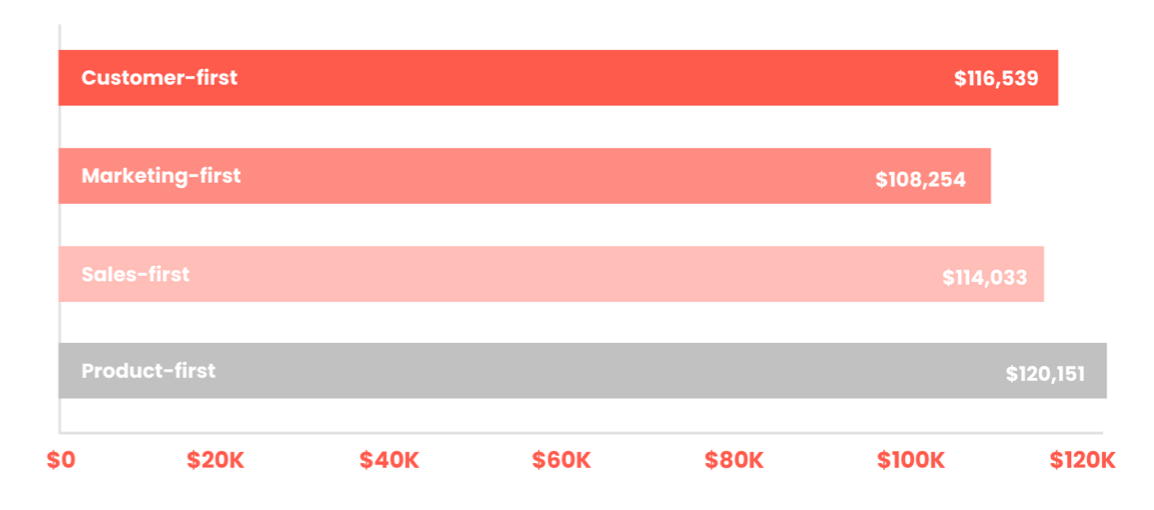
Who should Product Marketing report to?
The split for this one was actually pretty decisive:

Outside of the big four, the most common departments/positions given included Customer Ops/Experience, Sales & Partnerships, Technology, the Board, Chief Operating Officers and Revenue Ops. Just a couple of people said their Product Marketing department was its own entity.
When it comes to who you report to though one or the other isn’t necessarily right or wrong. We picked the brains of product marketers assigned to each to see what they thought.
Product
“How often do you hear a PO say "marketing doesn't need to know that” when a marketer asks about the intricacies of an asynchronous API? As a PMM reporting to Product, you are trusted to understand the most technical of specs and apply your magic to turn them into a message customers get excited about.
Working side by side with Product Managers allows a Product Marketer to participate in a product’s development process from the very beginning and be an integral part of its success, especially after everyone washes their hands.”
Anna Kovalenko, Product Marketing Manager at NMI
Marketing
“There are both pros and cons to being aligned with marketing but for me, the advantages are being directly involved with the end-to-end buyer journey, especially on the digital front where all the businesses are going, if not already there. It’s also easier to conduct customer-facing activities as you are on the same team as the events and marketing ops folks, etc., and you always have swag lying around for you and/or your customers.
“On the flip side, you’re perceived as general marketing and asked to pretty up presentations instead of working on strategic tasks, and you're further away from your product management colleagues and often find yourself in silos. The KPIs you’re tracked on are also more focused on marketing ones, basically site visits, organic growth, conversions, etc., and so not focused on the customer.”
Parag Pathak, Team Lead, Product Marketing at IBM Security
Business development
“I report into the division of Vendasta that focuses on growing our existing customers. The main benefits to this are that we get a closer understanding of our customer cohort, which allows us to build a stronger understanding of where they find value. This forces us to keep our key messaging up-to-date and highly specific.
“Reporting to a division also enables us to successfully collaborate with product, sales and marketing by working as the main line of unbiased communication between functional teams. Additionally, I find that for companies like Vendasta who have a wide variety of products and solutions, having product marketing focused on customer cohorts allows them to have more autonomy to build strategic plans using everything at their disposal.”
Rylan Morrin, Director of Product Marketing at Vendasta
CEO
“For someone who’s responsible for the go-to-market strategy, especially in hi-tech orgs, when releases are frequent and benefits for each persona are not obvious, the CEO can provide unique insight into messaging, new angles to tell a story, all consistent with his/her vision and north star metric.
“Not all CEOs are able to do that though, it depends on their background and skills. Reporting to the "right" CEO greatly helps any product marketing effort. Reporting to the "wrong” CEO on the other hand can be a total nightmare.”
Donato Mangialardo, CMO at Giunti Psychometrics
Let’s get personal
This section focuses on people-specific factors, like education, certification, how many products they manage, how long they’ve been in the industry, the number of hours worked, and more.
Certification & education
We’ve seen several discussions on Slack and online around product marketing certification and whether it’s needed for the role and although we already knew it wasn’t, our results confirm it doesn’t affect pay, either.
The vast majority of product marketers (77%) don’t hold any current certification and the salary difference between those that did and didn’t wasn’t significant enough to suggest the credential alone was the differentiator:
Do you have current product marketing certifications?

In terms of certification and job titles, there weren’t really any trends to report on. VPs of Product Marketing were most likely to have up-to-date paperwork (32%) and Product Marketing Managers least (19%). Outside of those though, the numbers were pretty up and down.

However, whether directly or indirectly, level of education did appear to play its part and the average salary of someone who didn’t go to college versus someone who had a Doctorate was more than $50,000 apart.

Number of people and products managed
Although plateauing slightly towards the upper end of the count, as expected, the more heads a product marketing manager oversees the more they earn.

And despite getting off to a slow start, a similar sort of trajectory occurs on a smaller scale when it comes to the number of products supported, too.
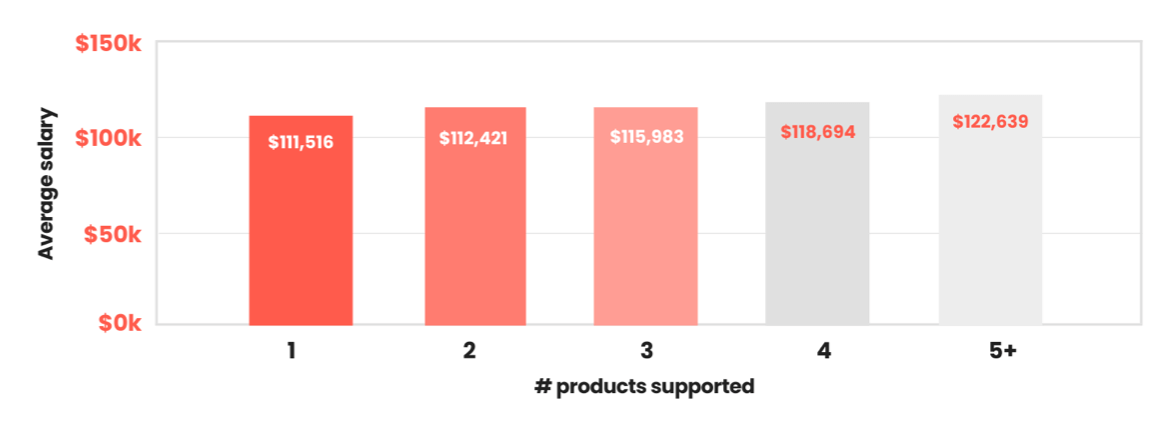
The increases can’t be attributed to more senior involvement either. As the below chart shows, the level of seniority to products supported ratios are all within a reasonably similar bandwidth across the board, which can lead us to assume product marketers are being compensated for the extra workload that comes with more products - perhaps just not as much as is arguably deserved.
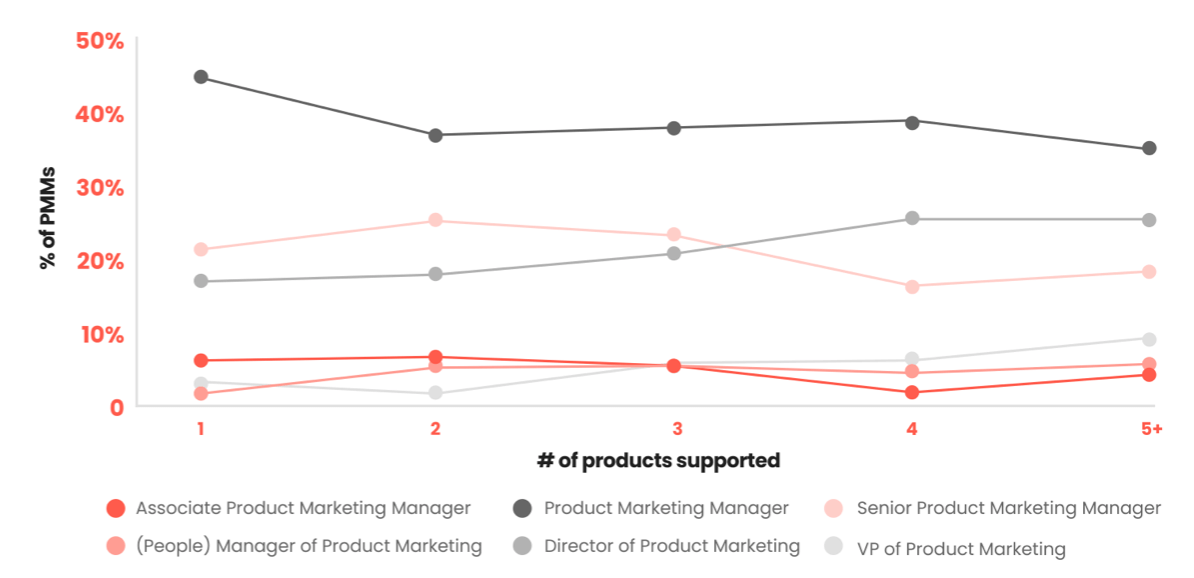
We caught up with Yoni Solomon, Head of Product Marketing at G2, to get his thoughts on pay in relation to the number of products managed.
“While these pay bands look consistent to what we're seeing in-market today, it's becoming clear that the thoughtfulness and structure we commonly see in Sales and Demand Gen comp plans are quite lacking in Product Marketing.
“As PMM importance and impact continue to be elevated in the coming years, I hope to see performance levers around number of products managed, product adoption, # of GTMs per quarter and top-line demand get built into the compensation packages of product marketers, all to ensure we're properly compensating our go-to-market teams for their performance both individually and in-support of our Product, Marketing and Sales orgs that we live at the intersection of.”
Number of hours put in
The average product marketer works 46 hours a week and bar one anomaly, this is far more than each’s respective national average.

† Data for India’s average work hours was taken from the National Sample Survey Office (NSSO)'s first periodic labour force survey (PLFS). Brazil was based on the country’s norm of eight hours Monday-Friday plus four hours on Saturday. All other averages came from the Organisation for Economic Co-operation and Development (OECD).
In San Francisco, the average climbed up to 50 hours per week and the upper 19% tallied a whopping 62 hours every seven days.
As you might expect, VPs of Product Marketing racked up the highest weekly total (51 hours) and those earlier in their career, Associate Product Marketing Managers, hit just below the product marketing average with 43 hours - but still way more than the overarching norms.
So, what’s contributing to product marketers’ long working weeks? Here’s what Tania Clarke, Senior Product Marketing Manager at Atlassian, had to say.
“I used to work for a company where I was supporting 11 product managers and a very large sales team as one person. The amount of work that goes with supporting that many people is exhausting and enormous and the ideal ratio should be 1:2 (1x PMM for 2x PMs) and a team of PMMs with resources like content marketing and demand gen to support a growing sales team.”
Minorities
Next, we asked our panel of product marketers whether they considered themselves to be part of a visible or invisible minority where they currently work. Around two thirds (65%) said they didn’t, just over one third (35%) said they did.
Whether they did or didn’t had no bearing on pay though and in fact, people who were part of a minority received a marginally higher remuneration.
Do you consider yourself part of a minority?

In-house vs remote
Working from home’s on the up full stop and it’s definitely just as present in product marketing. According to our survey, 56% of product marketers work from home at least one day a week and one in 10 are 100% remote.
Not everywhere was quite so into it though. On the map, not a single product marketer in the Middle East or South & Central America said they worked from home full-time and Asia (7%), Australasia (11%), Europe (8%) and North America (12%) dipped above and below the average.
So, did being in or out of the office impact pay? Yes, but perhaps not in the way you might have thought.
On average, remote product marketers earn $132,811 a year and in comparison, people who’re always in the office receive $109,247 - more than $23,000 less.

Product Marketing Managers, Senior Product Marketing Managers and Directors of Product Marketing were the most likely candidates to work remotely full-time and some titles did buck the trend.

The stage a company was at impacted this one too. For example, companies who were early pre-product market fit a) had significantly fewer remote workers and b) didn’t show much difference in pay at all.
In comparison, organisations categorised as late growth/scale-up returned a higher than average disparity between the two, $24,913 - again, in favour of remote workers.
“It’s very fascinating to see that remote PMMs earn more than folks who are in the office full-time. This helps confirm my theory that a distributed workforce is the way to go. We have a distributed team with team members on the west coast, central and east coast of the US, and their salaries are comparable irrespective of whether they are in office or remote.
“I advocate for remote work as that is key for work-life balance and with video conferencing technology, you feel like you are in the same room and can connect just like you would face-to-face.”
Div Manickam, Director of Portfolio Messaging (Product, Industry, and Solutions) at Boomi
Pay progression
In the last three years, the majority of product marketers have bagged between two and three pay rises. Just under one in 10 (8%) didn’t receive a single salary increase and the lucky 0.5% earned more than five.

As you can imagine, the product marketers who hadn’t had a raise in at least three years were least happy with their current compensation and of those who received more than five, the consensus was there’s still room for improvement.
Pay progression differed somewhat depending on where you are on the map too. Product marketers in the Middle East (19%) and South & Central America (14%) were most likely to have stayed on the same salary for the last three years, whereas people in North America were around 10% more likely than everyone else to have had three or more raises.
By title, Associate Product Marketing Managers were least likely to see any changes to their salary and 18% of (People) Managers of Product Marketing welcomed four or more - that’s 8% more than any other bracket.
Salary satisfaction
On the whole, the average product marketer is 7/10 happy with their current pay. The only continents who dipped below the norm were Europe and the Middle East who rated their satisfaction at 6/10.
Despite earning quite a bit more than the rest of the world, product marketers in North America were no happier with their wage than everyone else.

Of the 2% who said they weren’t happy one bit, almost two in five (39%) earned more than $125,000 and more than half (57%) were Product Marketing Managers.
On the opposite end of the spectrum, more than three-quarters (77%) of the product marketers who couldn’t be happier with their pay were based in North America - perhaps unsurprising given their higher overall base salary.
Outside of increased pay, the most prevalent pleas for change around compensation include invcentives such as:
- Quarterly bonuses instead of annual
- Some control over bonuses
- Better bonuses
- More authority and say in the role
- Incentives for effort beyond expectations
- More equity
- Profit-sharing
Salary: value happiness
Those who felt their salary reflected their role earned just under $20,000 more than product marketers who answered ‘No’ or ‘For now’.
Interestingly, just 14% of Associate Product Marketing Managers feel their current pay is fair for what they do. On the flip side, more than half (57%) of VPs of Product Marketing do.
Do you think your salary’s reflective of your role and everything it entails?

Geographically, despite receiving the lowest average salary of all the continents, product marketers in South & Central America were least likely to feel they weren’t being compensated fairly (13%).
Most likely to feel they’re underpaid for the work they do were product marketers in Europe (33%) and North America (33%) - despite the latter earning significantly more than Asia, Australasia and the Middle East.
And when it came to product marketing salaries in general, slightly more product marketers did (54%) than didn’t (45%) think they reflect the business value the role adds.
Do you think product marketing salaries in general reflect the business value the role adds?
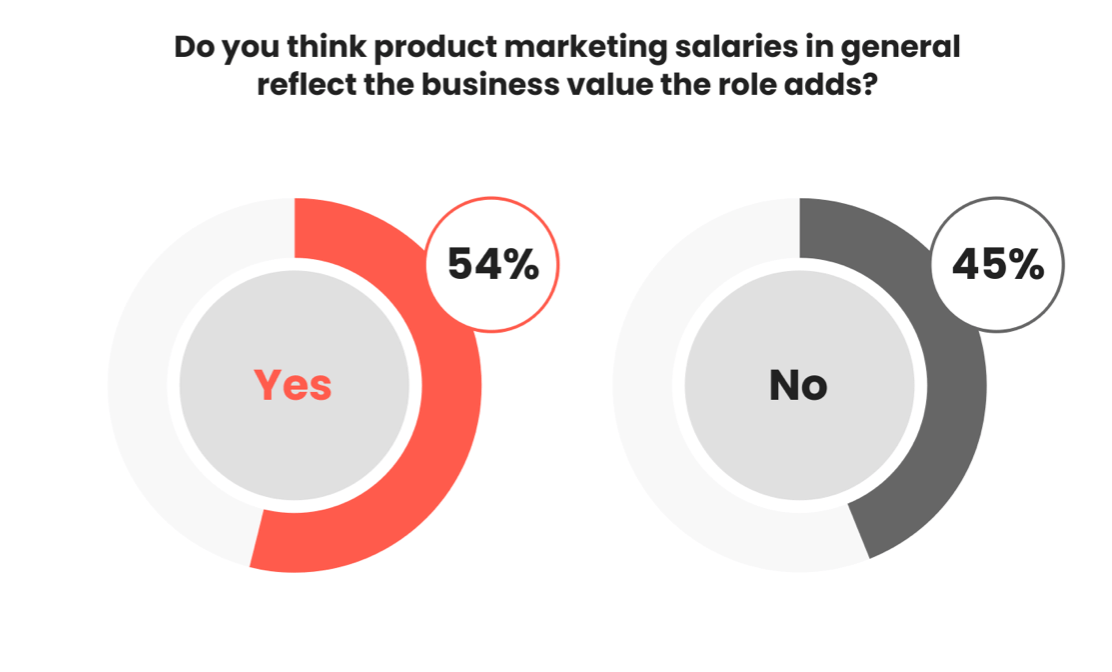
Is salary a sticking point?
When making career decisions, salary’s the first thing around one in six (18%) product marketers look for and women were more likely to hold this in higher regard than men (56% vs 42%).
Geographically, people in North America and the Middle East were slightly more likely than the average to take a salary-first approach (19%) - within North America though, Canadians were considerably above this (27%).
Those in Europe and Asia sat a few percentage points below the norm (14%) and some countries in Europe were even less bothered about salary than that:
Spain (4%)
Netherlands (5%)
Germany (10%).
So, if not salary, what do product marketers hold dearly during career decisions? Here’s what.

Career stability
If any CEOs or team leads are reading, watch out. More than half of product marketers are looking to leave their job - 14% actively and 38% passively, and Associate Product Marketing Managers are 5% more likely to want to jump ship than any other title.
There were variations depending on the type of product too. Slightly less than half (49%) of product marketers who deal with SaaS are on the job market compared to two-thirds (66%) of those who work with physical products.
If any CEOs or team leads are reading, watch out. More than half of product marketers are looking to leave their job - 14% actively and 38% passively, and Associate Product Marketing Managers are 5% more likely to want to jump ship than any other title.
There were variations depending on the type of product too. Slightly less than half (49%) of product marketers who deal with SaaS are on the job market compared to two-thirds (66%) of those who work with physical products.

Looking ahead to 2020, more than three in 10 (31%) product marketers want to leave their employer, a third (32%) want to change roles, and only a per cent (or four) more are content right where they are.

Of those who wanted to change employers, more than half (54%) said they don’t get support from above and slightly less (49%) weren’t happy with their pay.
And from the people who said they’re looking to switch up their position, 36% were Product Marketing Managers who’d been in the industry for 3.9 years and 25% were Senior Product Marketing Managers who’d been around for 6.2.
So, where are they looking to go? Their length of product marketing experience suggests they could be wanting to move up the ladder and this would align with the results in our State of Product Marketing (SOPM) report, but we want to know more...
Another possibility is that people are looking to leave the profession full stop and our SOPM survey earlier this year divulged that at the time, one in 20 product marketers were, in fact, looking to exit the field.
We spoke to Aaron Brennan, Director of Product Marketing at airSlate, to get his take on the numbers:
"I think there’s a multitude of different factors in people looking to change profession but I think one of the biggest pieces is that product marketing changes from place to place or it is incredibly executional for other teams and not a strategic position. When you go from one organization that has the view of product marketing as a writer to another company that wants it to be more of a marketer driving leads, it feels like you don't know what the role actually is and that’s a frustrating feeling.
“I do think it’s cause for concern because product marketers have turned into the everything role that takes on a lot of responsibility across the organization with no real foundation. They become a catch-all without any real view into “why is this being done” but not being the subject matter experts and unless organizations can truly understand the product marketing role, they’ll lose out on great talent that could be very strategic to an organization and help it grow."
Conclusion
We suspected it might be the case before we started this survey but our findings cement the role geography plays in product marketing pay and as well as monitoring overall salaries, it’ll be really interesting to see how these continental disparities play out over the coming years.
Another statistic we found particularly interesting was the number of product marketers looking to change employers and roles. Although we don’t have data from other industries to compare it to, 31% of product marketers breaking up with their employer next year alone strikes us as high.
So, what could be the cause? Our speculations include:
Lack of job recognition and satisfaction. Having spoken to numerous product marketers since we began, a relatively common consensus is that the role itself just isn’t valued enough. People are having to justify the worth of their work and to some, that could well be a role-changing deterrent.
Aaron Brennan touched on it and we agree, product marketing roles can massively vary from job-to-job. While some see this as a pro, understandably, others don’t like the instability and unknown. A product marketer can go from one job they love to the same position in another company that’s just worlds apart.
Given almost half of those looking to leave their current employer don’t think their salary reflects their role, pay could well be a driver and people might be looking for more financially fruitful careers.
Our next focal point is around leadership support. Almost four in 10 (38%) product marketers say they don’t have it and this more than likely feeds into the above issue of people wanting to leave their current company.
What can we do about it?
Martin Aguinis made a great point around leading with data and we absolutely second his words.
As well as that though, we just need to talk about it more. There are people in this world who don’t know product marketing exists and that needs to change. The same way everyone knows what the role of a sales rep, accountant and marketer entails, everyone needs to understand that of a product marketer.
The final thing we’d like to comment on is salary satisfaction. Our results uncovered 7/10 is the average rating within product marketing and 67% think their salary reflects their role, at least for the time being. Compared to other broad, third-party stats, that’s not actually all that bad - perhaps even slightly better. For example, research published by The Conference Board showed less than half (46.4%) of Americans are satisfied with their wage.
Richard King, Founder of PMA, gave his insights on our findings.
“This survey is the first of its kind for both us and the industry and we’re really pleased to finally represent product marketers and their salaries this way.
“Lots of really interesting statistics came out and these will hopefully help shape both individual and industry-wide movements going forward. We hope everyone finds the content as useful and insightful as us and we already can’t wait to run the 2020 edition and start comparing year-on-year.”
P.s. Curious about the calculations?
We split the difference of each salary bracket right down the middle. So, for example, a product marketer who said they earn between $125,000 to $150,000 would go down as $137,500 and for people who fit into the <$25,000 or >$200,000 bands, we used the upper and lower limits given in each option.
Basically, what that did was ensure each bit of data we sliced and diced was based on the averages from within it.

